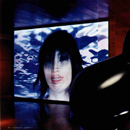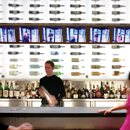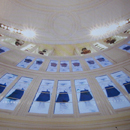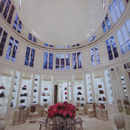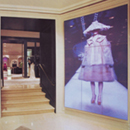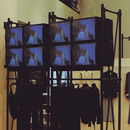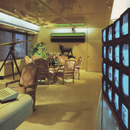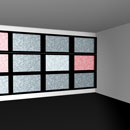
Pulsate
Pulsate describes a group of computer monitors (screens or displays) that create a visually active and animated plane. The effect achieved by the content projected through the monitors constantly alters the spatial experience through light, sound, motion and passage of time. Pulsate can also be installed as an electronic billboard in which an entire wall plane made of monitors. more
Pulsate | Transformative Interior
research
Effect
Pulsate utilizes a linear or grid organization of the monitors to produce a visually and sometimes acoustically stimulating space. Occupying an area of an interior plane, each monitor acts as a module to create a larger impact of sensory input, such as light and sound, into the space. As the scale of the installation increases, these screens may encompass an entire wall, floor or ceiling. The degree of impact depends on the scale and composition of an installation, as well as the relationship with architectural elements, content and context. The dance club, Point After, on the Carnival Destiny cruise liner (1996) was an exemplar of Pulsate. Designer Wynne Wilson Gottelier stacked together monitors that covered all the wall and ceiling planes. Psychedelic images were played on the screens, which provided a constantly changing pattern of colors and shapes.1
Pulsate also addresses the passage of time making the space it occupies four-dimensional. When monitors display broadcasted material, or a live feed, an immediate sense of time is present in the space and through movement. Live images tend to convey an imminent atmosphere when contrasted with pre-recorded visuals.
Certain conditions of Pulsate are reminiscent of the effect of the Chameleon (Intype). Chameleon describes the transformation of an interior by manipulating and varying solid areas of colored light over time on a single plane or throughout the entire spatial envelope. The event emerges when multiple colors cycle at regular intervals on programmable controls or by manual means.
In Pulsate, when the planes that are adjacent to monitors are made of reflective materials, such as polished hardwood or a metallic surface, the screen reflects more colored light and pattern into the space. A monochromatic palette of surrounding planes housing luminous planes also mirror the colors transmitted. Among the chronological examples discussed, Morimoto in Philadelphia demonstrates this hybrid quality.2
The following research examines the chronological sequence and significance of Pulsate as an archetypical display device in the interior environment.
Technology
Pulsate as a light source conveys movement depending on the pace of image change. The technological root of this phenomenon is a strobe light, or stroboscope, patented in 1933 by H.E. Edgerton. A stroboscope generates succinct, repeating bursts of light, which allows viewers to see the movement of objects as a series of static images, while inducing a dynamic spatial atmosphere. The invention was used to study motion in a visually segmented way. Constantly blinking images though display devices heightened the level of visual stimulation in spaces.
Computer monitors and display screens have become ubiquitous in commercial and institutional settings. This phenomenon started with television, an image-transmitting machine that found wide appeal in American households for entertainment. However, monitors that supply information and image displays occur in numerous settings such as medical, educational, security, as well as for pure decoration. Recent technology has also allowed people to be engaged in two-way communications, rather than being passive spectators. Touch-screen technology, for example, proved to be a key mechanism and human and machine interface. A touch-screen, sensitive to the touch of a finger or stylus, was used on ATM machines, retail point-of-sale terminals, car navigation systems, medical monitors, mobile phones and personal digital assistants (PDAs). Video conferencing is another good example of a communication event established between two parties through monitors.
Among the many display technologies, Cathode Ray Tube (CRT), a component of traditional television, Liquid Crystal Display (LCD) and Plasma Screen Display (PSD) were the most commonly utilized practices. The CRT was the first to deliver visually broadcasted materials. In 1897, German scientist named Karl Braun invented the main component of the cathode ray tube, which is a specialized vacuum tube that can transfer refracted electron beams into images. Three decades later, in 1927, American inventor Philo Farnsworth filed a patent for a device that transmitted an image using six horizontal lines on a screen. However, in order to perfect the system, he needed significant funding. The Radio Corporation of America (RCA) paid Philo Farnsworth one million dollars for the rights to his patents, although they had an in-house inventor, Vladimir Zworykin, a Russian physicist who filed a patent in 1938. Both Zworykin and Farnsworth are credited for the invention of television.3
Since its invention, the CRT dominated the television manufacturing industry, while Plasma display and LCD struggled to become viable alternatives due to high production costs. In 1964, the Plasma Display Panel was invented by Donald Bitzer, Gene Slottow and Robert Willson at the University of Illinois. Plasma displays contained noble gases sandwiched between two glass screens. It is used for large display areas covering up to 12.5 feet diagonally, which was impossible for a CRT monitor to achieve. Despite its high cost, Plasma displays were used in high-profile lobbies and stock exchanges. The consumer-grade color plasma screen was first developed by Fujitsu in 1992.4 In mid-2000, as production costs significantly diminished, the Plasma television market became substantially larger.
A LCD was essentially a thin, flat electronic visual display that used the light modulating properties of liquid crystals. Conceived in the early 1900s, LCD technology did not become fully commercialized until the end of that decade. Used for small personal appliances, such as digital clocks, calculators, compact disc players, computer monitors and equipment panels, LCD screens were used in many everyday devices. Color LCD television was developed in 1970s and wide spread production started in the late 1990s. In 2007, sales of LCD televisions surpassed that of the CRT televisions for the first time. Compared to the CRT, the thin screen made image display lightweight, larger and more portable.5
LCD technology was further developed to use LED backlights instead of fluorescent lights. In 2004, Sony introduced the first commercial LED television which fueled a race to produce the thinnest TV in the world. In 2010 LG's television debuted with a television that was less than 7 millimeters thick.6 LED backlit televisions also provided the best image quality with a contrast ratio surpassing 6,000,000:1. By 2010 major electronics companies including Samsung, LG, Toshiba, Sony and Panasonic all developed LDD televisions in three-dimension (3D).
The Impact of Television
Sentiments, emotions and conditioned responses of television viewing have greatly influenced how people respond to the presence of monitors in the interior and how the content is delivered. The ubiquitous nature and prevalence of monitors are obvious; nonetheless many studies attempt to measure the type and degree of impact that television has on its viewing public. This provides a background to understand the implications of incorporating monitors within interior spaces.
With the end of the World War II in late 1940s, the American economy was booming; many households enjoyed a more affluent life style that included watching television. In 1949, only two-percent of American homes had a television set; a year later that figure had risen to ten-percent. The ownership of televisions had an exponential growth; by 1960 nearly all American homes owned a television.7 The growth of broadcasting channels also ascended to include hundreds of cable and satellite offerings today.
Statistics in 1990 revealed that "the Average American spends about four hours a day watching television, with older adults watching the most of any group; even teenagers, who watch the least amount of television, still spend an average of nearly twenty-four hours a week in front of the TV set."8 In 2008, the number of hours increased to five hours a day according to Nielsen, a leading research firm.9 Numerous published studies are dedicated to how much people spend watching television; statistics point to the simple fact of the ubiquity and pervasiveness of television in modern life.
Monitors and screens in commercial interiors started as functional and practical applications. Some merely attempted to recreate the ambience of a living room, while others discovered ways to integrate informational monitors into interior design. Pulsate focuses on the latter examples, which create a luminous surface providing sound, motion and a sense of time into the space. In the 1980-decade video artists offered more creative means to think about monitors in space, and the possibilities of monitor displays in the interior.
Video Art | Monitor as Medium
Video artists were the first to discern monitors as a medium of art. Some focused on the manipulation of video images, while others created environment art, in which artists used monitor(s) to create sculptural installations for people to experience. Many demonstrations were multiples stacked to create a wall of monitors within a space, such as a corridor or staircase or on a column. Exploring the unique capability of monitors and recording devices, video artists provided new ways to experience and think about image displays and their impact on interior space and a viewing audience. Many contemporary interiors were inspired by these art installations.
Nam June Paik, a pioneer in the genre of video art, produced sensational work in that it challenged established conventional relationships between art and viewers of art. Viewers were faced with unavoidable demands for their attention. Each device displayed images that created visual drama in spaces. Paik's work not only "animates the otherwise merely passive spectator,"10 but also the spatial envelope, in which the monitors were housed. The effect was a constantly changing perception of space. When the screens were directly embedded in architectural planes, the transformative quality of a room was intensified.
Bruce Nauman's "Corridor Installation" (1970) created a setting where one confronted a monitor within a narrow corridor that was thirty-four feet long and twenty-inches wide. The sight of monitors at the end of two walls lured curious viewers inside. The occupant soon discovered that the upper monitor was a live view of his or her own back. As one walked closer to the monitor to better see his or her own image, the image became smaller, because one was walking away from the camera. Most people instinctively turned back, hoping to see their faces, but it was impossible. In this installation, a person became am active participant, a victim, of the installation. One was meant to feel frustrated, confused or even trapped-feelings that may have unpleasant, but familiar.11 The monitors at the end of the corridor gave viewers a reason to walk down the tight space. The anticipation and curiosity of discovering something on the monitor made one step inside, despite the apparent physical discomfort.
The technology of Closed-Circuit Televison (CCTV) made its appearance in the art installation "Command Performance" (1974) by artist Vito Acconci. The audience was invited to act, to assume the role of performer. In Installation Art: A Critical History, Claire Bishop described Acconci's work in detail:
"A closed-circuit television camera was trained upon the spot-lit chair, filming whoever sat in it; in front of chair was a monitor playing a tape of Acconci inciting the visitors to step into the limelight and ‘perform' for him/ herself. The camera linked the participants' image to a monitor positioned behind them at the entrance of installation - and which they would have seen upon entering. Viewers became both passive observers and active participants in the piece, watching Acconci on video while bringing the work to completion by sitting in the chair and ‘performing' for other visitors who enter the installation."12
Acconci's work made a commentary on the "to-see-and-be-seen" mentality prevalent in contemporary society. Some applications of Pulsate utilized the CCTV technology precisely to enhance a person's desire to be seen on monitors at restaurants, bars and other social venues.
Shigeko Kubota's work, "Duchampiana: Nude Descending a Staircase," (1976) also put a monitor into a spatial context. Kubota interpreted Marcel Duchamp's painting, "Nude Descending a Staircase," by playing homage to Duchamp's notion of "transforming the boundaries of art by challenging the institutional definitions of the art object." Her use of a monitor as a medium was meant to challenge high art. A monitor depicted a subject in a matter-of-fact way, in the same way in which television was often consumed.13
Using sixteen stacked television monitors, four video recorders and a specially built, computer-controlled video switcher, "Magic Wall" (1984) was a collaboration of artists Joanne Culver, Frank Dietrich and Zsuzsanna Molnar. They intended to exhibit complementary or contradicting images in groups "to move beyond the limitations of everyday TV," which showed a single image on a screen. By controlling the speed and rhythm of each screen, a matrix of video image patterns was created. Artists determined the rhythm and patterning of the "Magic Wall" by writing computer programs that ordered the relationship of the images.14 "Magic Wall" was the first attempt of a wall made entirely made of monitors. A monitor became a building block that inspired new approaches of incorporating monitors in contemporary interior design.
Although the video art movement flourished during the 1970 and 1980 decades, wide application of display devices in commercial interiors did not become economically feasible until the 1990s. Early technical challenges and steep budgetary costs posed some difficulty. Sizable control rooms, power requirements and the arduous production of video content made Pulsate an avant-garde interior feature. Nonetheless, designers found Pulsate a worthy investment, a timely and innovative approach to attract consumer attention, as well as promote and cultivate brand identity.
Chronological Sequence
Pulsate reflects today's aggression in information delivery. Pulsate fuses the demand for access to as a barrage of information, sounds and sights-and distribution via the spatial envelope. Pulsate is used to exhibit, broadcast and reinforce highly scripted messages within an interior space, especially in corporate and retail interiors where strong brand identity is desired. When used in restaurants and bars, Pulsate takes on a type of voyeurism that has become a social norm in contemporary society. Using abstract or literal imagery, Pulsate is also used for a purely decorative treatment, dictating the atmosphere of the space. In this case, the color, shape, form, and patterns appearing on the screen offer visual stimulation into the space, free of concrete messages.
Before monitors made their appearance in commercial interiors, light boxes were used to create more dynamic spaces. In 1983 interior designer Penni Paul featured a wall of light box monitors for the office of land developer Lewis Wolff. The monitors were organized as floor-to-ceiling modularized frames to provide a dramatic focal point in the room. Glowing, static images showcased the properties for sale. Blacked-out interior walls, upholstered chairs and minimal lighting reminded one of being at the cinema.15 Although static, light box installations, such as the one for the Lewis Wolff office, paved the way for the animated images of Pulsate.
In 1987 Ellen McCluskey Associates used Pulsate in a private office setting for a company president. Sixteen monitors, organized into a four-by-four grid, dominated one wall with trading and marketing information.16 The group of micro-sized monitors was somewhat reminiscent of square glass blocks that were used in interiors as light-diffusing element. The overall effect of Pulsate provided an ever-transforming vista that overturned at a rapid pace.
In 1993 Gwathmey Siegel & Associates chose Pulsate as a lobby strategy for the advertising agency, D'Arcy Masius Benton & Bowles Headquarters. Designers mounted twelve monitors, six across and two down, on the back wall, immediately behind the reception desk.17 The monitors captured one's attention and provided the only spots of color in its White Box (Intype) setting.
Beginning in the 1990s, Pulsate was employed for public display, and it sometimes became an "interior window." Multiple screens formed a sizable display grid that constantly transmitted promotional images and broadcasted jingles. As the proportion of monitors occupying a wall space increased, Pulsate became more aggressive, upfront and overpowering in terms of visual stimulation. In 1991 Viacom International, a large broadcasting company with many networks, used Pulsate to set the tone in media production. Left of the reception desk in the lobby of the MTV network office, a huge screen made of twelve monitors transformed an otherwise plain wall. Pulsate also solved the problem of a long elevation or corridor. At Viacom, Pulsate was used on the floor, as well as the wall.18
Pulsate expanded into retail stores during the mid-1990 decade. When architect Peter Marino designed the flagship store for Donna Karan (1994) in Jeddah, Saudi Arabia, he incorporated Pulsate as a part of display system, directly exposing buyers to audio and visual advertising. It was impossible to bypass the captivating monitors as shoppers examined merchandise on the racks below. Movement from the models in video induced a lively and upbeat atmosphere throughout the store.19 In 1996 the DKNY store in London also employed Pulsate to bring New York City into the space. The presence of screens was reminiscent of a billboard-dominated city-scape, such as Times Square. Against its White Box interior, the four screens created views onto the rapid paced world of fashion where trends emerge and die overnight. "Oversized video screens whose moving images of news and fashion events inject a kinetic energy to the space,"20 while instantly branding the space as that of DKNY. The screen frame and spacing between monitors appeared like an interior window with windowpanes and mullions.
Phillips Janson Group Architects incorporated Pulsate in the form of a sixteen-monitor screen at the United Colors of Benetton's Sportsystem store (1994). Pulsate was again placed in the backdrop of a White Box. In contrast to pristine finishes, such as ivory painted walls and delicate iron railings, the electronic field set the overall tone for the energetic, dynamic and kinetic vigor of Sportsystem's space. Pulsate contributed to Benetton's effort to unify the different types of sports specialties under one corporate brand. Eleven manufacturers' promotional video clips or a rapid scramble-effect of multiple pictures followed by the log of Benetton are featured.21 Images of athletes animated the wall plane, while captivating shoppers with audio stimulation and visual motions that made hearts beat faster. The monitors occupied an entire wall n from floor to ceiling. The sheer size of Pulsate created an electronic billboard within the interior space.
In restaurants and bars, Pulsate has a voyeuristic quality, an idea originally pursued by Bruce Nauman's "Corridor Installation" and Vito Acconci's CCTV art. Restaurants featuring Pulsate become a social haven for those who enjoyed others' attention and for those who liked people-watching. Patrons become active participants, actors for a moment. Privacy was not a priority in these spaces, but one could control visibility by bypassing the bar, where the cameras and screens were usually concentrated. Nonetheless, the presence of a camera instilled a heightened awareness of oneself, and this excitement led to a more active scene for dining and socialization.
In New York City's Seagram Building, architects Diller+Scofidio positioned a video camera in the doorway of the Brasserie restaurant (2000) in order to film patrons as they entered. Captured images were then displayed on monitors on the back wall over the bar, becoming provisional art. The environment "exaggerates the exhibitionist act of seeing and being seen, heightening the awareness of both the absurdity and beauty of social rituals."22 The linearity of a row of screens echoed the stream of bottles on the display wall behind the bar; regular placement of these objects created a visual rhythm. The act of coming through the entrance was constantly recorded and broadcasted. As a whole, the screens showed an arbitrary orchestration of similar motions happening at different rates. Movement was emphasized and interpreted in many ways in the Brasserie. Nothing in the interior physically moved, but film suggested constant movement that kept patrons visually engaged.
The Remote Lounge in Manhattan, designed by Jordan Parnass in 2002, was a technophile's dream in lounge form. More than sixty video cameras recorded live views of the space. Some of the cameras were akin to pendant lights; they were suspended from the ceiling above the bar. Rows of screens above the bar broadcasted almost all activities.23 Faces and bodies, seen in-person and also through live videos, doubled visual stimulation. There were also individual computer stations with telephones where customers could change the channels to see different camera views, phone those congregating at the main stage or send text messages that appeared in the LED tickers at the bar. The lounge closed in 2008, but until then, it provided an unique cyber venue.
When designing Morimoto in Philadelphia in 2002, Karim Rashid designed an unconventionally long space of 21-feet by 240-feet, because "it forces creativity."24 In an effort to push the envelope, screens spanning from floor to ceiling became a dramatic physical statement that served as an introduction to the restaurant. The electronic billboard was comprised of multiple screens, displaying an exaggerated video of a virtual hostess. Against the backdrop of wave-patterns, the image slowly changed in harmony with Rashid's signature style of organic lines and smooth edges. The blue light transmitted from the monitor was bounced off the polished wood ceiling and floor, creating a changing colored volume like Chameleon (Intype). Pulsate in Morimoto assertively defined the identity of the hip Japanese-fusion restaurant headed by the celebrated chef Morimoto.
For his luxury brand clients, Peter Marino made Pulsate a design strategy in retail environments to maximize the promotional aspect while adding theatrical flamboyance. In Paris, the 17th century French Mansion in Paris was renovated into a Christian Dior Boutique. In accordance with the exaggerated style of John Galliano, the legendary designer at Dior, a plasma screen showing video art by Oyoram filled window openings as a backdrop for the merchandise. These openings ringed the upper reaches of the double-height entry rotunda, creating a large enclosed, overpowering experience of Pulsate. Screens placed within the framed voids became a successful strategy for historical adaptation. The rotunda connected to individual rooms that housed various types of Dior merchandise. Pulsate was used in the connecting passage to emulate the movement of a fashion runway. The larger-than-life size figures strutted towards shoppers who faced the screens. The space was expanded beyond the physical wall, thus transporting a customer into another time and space. Marino claimed that "as a shopper, you are part of the scene."25 The result was a powerful presence of the Dior brand that was created by the juxtaposition of classic architectural elements with technology.
Pulsate testifies to the diverging role of interior design in the 21st century. An interior may simply be an envelope through which images are transmitted. The active quality of monitors as objects infused a kind of kinetic energy into spaces that entertained its occupants. Pulsate added complexity through the play of visualization and voyeurism, energy and transformation. Since the late 1980 decade, Pulsate provided an infinite possibility of how interior spaces can look, sound and feel.26
end notes
- 1) Point After Dance Club, Carnival Cruise Line [1996] Joe Farcus, marine architect for Carnival Cruise Line in Robert S. Simpson, Lighting Control: Technology and Applications (Oxford, UK: Robert S. Simpson, 2003), 171; PhotoCrd: Anonymous.
- 2) Morimoto [2002] Karim Rashid, design; Philadelphia, Pennsylvania in Craig Kellogg, "Chef's Choice," Interior Design 73, no.2 (Feb. 2002): 158-59; PhotoCrd: David Joseph.
- 3) Albert Abramson, The History of Television, 1880 to 1941 (North Carolina: Albert Abramson, 1987): 34.
- 4) Kenji Awamoto, et al, "Progress in Large Screen Plasma Display and New Approach for Extra-Large Screen System with Plasma Tube Technology," Journal of Display Technology 2, no. 4 (Dec. 2006): 679.
- 5) Yutaka Ishii, "The World of Liquid-Crystal Display TVs: Past, Present, and Future," Journal of Display Technology 3, no. 4 (Dec. 2007): 351-51.
- 6) CNN International Edition, "LG Flat-Screen TV Gets Skinny," Jan. 10, 2010 http://www.cnn.com/2010/TECH/01/06/lg.flatscreen/index.html (Accessed June 14, 2010).
- 7) A. C. Nielsen, Nielsen Report on Television (Northbrook, IL: Nielsen, 1993), n.p.
- 8) John C. Condry, The Psychology of Television (Hillsdale, N.J.: L. Erlbaum Associates, 1989), 31.
- 9) The Nielsen Company, "Historical Daily Viewing Activity Among House Holds and Perons 2+," http://blog.nielsen.com/nielsenwire/wp-content/uploads/2009/11/historicalviewing.pdf (Accessed 4/27/10).
- 10) "Tricolor Video" [1982] Nam June Paik, artist; Musee National d'Art Moderne, Centre Georges Pompidou, Paris in Nam June Paik, Christoph Brockhaus, Gottlieb Leinz, Wulf Herzogenrath, Nam June Paik: Fluxus, Video (London: Hayward South Bank Board, 1988), 6.
- 11) Corridor Installation [1970] Bruce Nauman, artist; Guggenheim Museum, New York City in Barbara London, "Time as Medium: Five Artists' Video Installations," Leonardo 28, no. 5 (The MIT Press, 1995): n.p.
- 12) "Command Performance" (1974) Vito Acconci, artist; New York City in Claire Bishop, Installation Art: A Critical History (New York: Routledge, 2005), 68.
- 13) Duchampiana: Nude Descending a Staircase" [1976] Shigeko Kubota, artist; Museum of Modern Art, New York City in John G. Hanhardt, "Video Art: Expanded Forms," Leonardo 23, no. 4 (The MIT Press, 1990): 437; Robert Smith, "Review / Art; Sleek Video Sculptures by Shigeko Kubota," The New York Times (May 24, 1991).
- 14) "Magic Wall" [1984] Joanne Culver, Frank Dietrich, Zsuzsanna Molnar, artists in Joanne Culver, Frank Dietrich and Zsuzsanna Molnar, "Magic Wall: A Multi-Monitor, Computer-Controlled Installation," Leonardo 17, no. 2 (The MIT Press, 1984): 88-89.
- 15) Office, Lewis Wolff Residence [1983] Penni Paul Interiors, interior design; Los Angeles, CA in Monica Geran, "Executive Privilege: A Very Personal and Atypical Office Designed by Penni Paul, ASID for a Los Angeles Developer," Interior Design 54, no. 4 (April 1983): 188; PhotoCrd: Toshi Yoshimi.
- 16) Private Office [1987] Ellen McCluskey; New York City in Monica Geran, "Executive Privilege," Interior Design 58, no. 8 (Aug. 1987): 197; PhotoCrd: Phillip H. Ennis.
- 17) Headquarters for D'Arcy Masius Benton & Bowles [1993] Gwathmey Siegel Architects; New York City in Edie Cohen, "Three Advertising Agencies by Gwathmey Siegel," Interior Design 64, no.1 (Jan. 1993): 89; PhotoCrd: Paul Warchol.
- 18) Lobby, MTV; Viacom International [1991] Kohn, Pederson, Fox, Conway Associates; New York City in Andrea Loukin, "Viacom International," Interior Design 62, no. 9 (Sep. 1991): 194; PhotoCrd: Elliot Kaufman.
- 19) Donna Karan Boutique [1994] Peter Marino Associates; Jeddah, Saudi Arabia in Monica Geran, "Peter Marino: the Bi-level Donna Karan Boutique in Jeddah Dramatizes the Duality of the Fashion Designer's Casual and Dress-up Collections for Saudi Women," Interior Design 65, no. 11 (Sep. 1994): 143; PhotoCrd: Peter Aaron/ ESTO.
- 20) DKNY [1998] Peter Marino Architect; London, UK in Edie Cohen, "Peter Marino for DKNY," Interior Design 6, no. 5 (Apr. 1998): 119; PhotoCrd: Chris Gascoigne.
- 21) Benetton Sportsystem Store [1994] Phillips Janson Group Architects; New York City in Monica Geran, "Phillips Janson Group: Benetton Sportsystem Showroom, New York City," Interior Design 65, no. 6 (May 1994): 206; PhotoCrd: Whitney Cox.
- 22) The Brasserie restaurant, Seagram's Building [2000] Diller+Scofidio architect; New York City in Aaron Betsky, "Diller+Scofidio," Architecture 89, no. 6 (Jun. 2000): 142; PhotoCrd: Diller+Scofidio +Renfro; "The Brasserie,"
http://www.dillerscofidio.com/brasserie.html (Accessed Nov. 23, 2009). - 23) Remote Lounge [2002] Jordan Parnass Digital Architecture; New York City in Lisa Alsenas, "On Candid Camera," Interior Design 73, no. 6 (Jun. 2002): 62, pl. 1; PhotoCrd: Jordan Parnass.
- 24) Morimoto [2002] Karim Rashid; Philadelphia, Pennsylvania in Craig Kellogg, "Chef's Choice," Interior Design 73, no.2 (Feb. 2002): 158-59; PhotoCrd: David Joseph.
- 25) Christian Dior Boutique [2008] Peter Marino Architect; Paris, France in Mailery R. Morgan, "Dior, J'Adore," Interior Design 79, no. 2 (Feb. 2008): 165, 167; PhotoCrd: Jimmy Cohrssen; Wallpaper Magazine, "Christian Dior: Retail Directory 2007" http://www.wallpaper.com/directory/398 (Accessed 4/ 17/ 2010).
- 26) Evidence for the use and the chronological sequence of Pulsate as a Transformative Interior archetype and its chronological sequence was developed from site visits conducted by the researcher, Elizabeth Erin Lee, in the 2007 to 2010 period in New York City and the following print sources: 1970 Corridor Installation [1970] Bruce Nauman, artist; Guggenheim Museum, New York City in Barbara London, "Time as Medium: Five Artists' Video Installations," Leonardo 28, no. 5 (The MIT Press, 1995): n.p.;/"Command Performance" (1974) Vito Acconci, artist; New York City in Claire Bishop, Installation Art: A Critical History (New York: Routledge, 2005), 68;/ Duchampiana: Nude Descending a Staircase" [1976] Shigeko Kubota, artist; Museum of Modern Art, New York City in John G. Hanhardt, "Video Art: Expanded Forms," Leonardo 23, no. 4 (The MIT Press, 1990): 437;Robert Smith, "Review / Art; Sleek Video Sculptures by Shigeko Kubota," The New York Times (May 24, 1991) / 1980 "Tricolor Video" [1982] Nam June Paik, artist; Musee National d'Art Moderne, Centre Georges Pompidou, Paris in Nam June Paik, Christoph Brockhaus, Gottlieb Leinz, Wulf Herzogenrath, Nam June Paik: Fluxus, Video (London: Hayward South Bank Board, 1988), 6;/ Office, Lewis Wolff Residence [1983] Penni Paul Interiors, interior design; Los Angeles, CA in Monica Geran, "Executive Privilege: A Very Personal and Atypical Office Designed by Penni Paul, ASID for a Los Angeles Developer," Interior Design 54, no. 4 (April 1983): 188; PhotoCrd: Toshi Yoshimi;/ "Magic Wall" [1984] Joanne Culver, Frank Dietrich, Zsuzsanna Molnar, artists in Joanne Culver, Frank Dietrich and Zsuzsanna Molnar, "Magic Wall: A Multi-Monitor, Computer-Controlled Installation," Leonardo 17, no. 2 (The MIT Press, 1984): 88-89;/ Private Office [1987] Ellen McCluskey; New York City in Monica Geran, "Executive Privilege," Interior Design 58, no. 8 (Aug. 1987): 197; PhotoCrd: Phillip H. Ennis / 1990 Lobby, MTV; Viacom International [1991] Kohn, Pederson, Fox, Conway Associates; New York City in Andrea Loukin, "Viacom International," Interior Design 62, no. 9 (Sep. 1991): 194; PhotoCrd: Elliot Kaufman;/ Headquarters for D'Arcy Masius Benton & Bowles [1993] Gwathmey Siegel Architects; New York City in Edie Cohen, "Three Advertising Agencies by Gwathmey Siegel," Interior Design 64, no.1 (Jan. 1993): 89; PhotoCrd: Paul Warchol;/ Donna Karan Boutique [1994] Peter Marino Associates; Jeddah, Saudi Arabia in Monica Geran, "Peter Marino: The Bi-level Donna Karan Boutique in Jeddah Dramatizes the Duality of the Fashion Designer's Casual and Dress-up Collections for Saudi Women," Interior Design 65, no. 11 (Sep. 1994): 143; PhotoCrd: Peter Aaron/ ESTO;/ Benetton Sportsystem Store [1994] Phillips Janson Group Architects; New York City in Monica Geran, "Phillips Janson Group: Benetton Sportsystem Showroom, New York City," in Interior Design 65, no. 6 (May 1994): 206; PhotoCrd: Whitney Cox;/ DKNY [1998] Peter Marino Architect; London, UK in Edie Cohen, "Peter Marino for DKNY," Interior Design 6, no. 5 (Apr. 1998): 119; PhotoCrd: Chris Gascoigne / 2000 The Brasserie restaurant, Seagram's Building [2000] Diller+Scofidio architect; New York City in Aaron Betsky, "Diller+Scofidio," Architecture 89, no. 6 (Jun. 2000): 142; PhotoCrd: Diller+Scofidio +Renfro; "The Brasserie,"
http://www.dillerscofidio.com/brasserie.html (Accessed Nov. 23, 2009);/ Morimoto [2002] Karim Rashid; Philadelphia, Pennsylvania in Craig Kellogg, "Chef's Choice," Interior Design 73, no.2 (Feb. 2002): 158-59; PhotoCrd: David Joseph;/
Remote Lounge [2002] Jordan Parnass Digital Architecture; New York City in Lisa Alsenas, "On Candid Camera," Interior Design 73, no. 6 (Jun. 2002): 62, pl. 1; PhotoCrd: Jordan Parnass;/ Christian Dior Boutique [2008] Peter Marino Architect; Paris, France in Mailery R. Morgan, "Dior, J'Adore," Interior Design 79, no. 2 (Feb. 2008): 165, 167; PhotoCrd: Jimmy Cohrssen; Wallpaper magazine, "Christian Dior: Retail Directory 2007" http://www.wallpaper.com/directory/398 (Accessed 4/ 17/ 2010).
bibliographic citations
1) The Interior Archetypes Research and Teaching Project, Cornell University, www.intypes.cornell.edu (accessed month & date, year).
2) Lee, Elizabeth Erin. "Theory Studies: Contemporary Archetypical Practices of Transformative Interior Design. M.A. Thesis, Cornell University, 2010.

